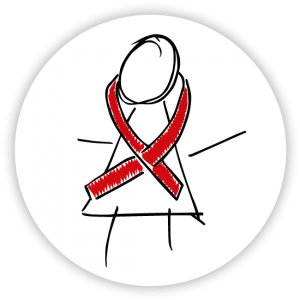Inconsistencies between real-world data from UK and Ireland and EU recommendations for new antiretrovirals in pregnancy
10 August 2017. Related: Conference reports, Pregnancy, Paediatric Workshop 9 Paris 2017.
 Polly Clayden, HIV i-Base
Polly Clayden, HIV i-Base
Linking European Medicines Agency (EMA) labelling with real-world use of newly approved antiretrovirals in pregnancy in UK and Ireland showed inconsistencies between recommendations. Results from this study by UCL Great Ormond Street Institute of Child Health were presented at the 9th International Workshop on HIV Paediatrics.
Data on safety and pregnancy outcomes are limited for new antiretrovirals as pregnant women are excluded from registrational trials. The EMA issues detailed guidance to better assess risk of exposure in pregnancy and lactation, during the post-marketing phase.
The vertical transmission rate in UK and Ireland is less than 0.4%. This is because a high proportion of women (60% in 2012–2014) conceive while already taking antiretroviral therapy (ART) and those initiating ART in pregnancy start as early as possible.
In order to evaluate the consistency between EMA safety information and recommendations and clinical experience to date, investigators compared labelling and real world use of three newly approved agents: rilpivirine (RPV), dolutegravir (DTG), and cobicistat (COBI).
Data sources were: the EMA public database (the European Public Assessment Reports and the Summary of Product Characteristics) for safety information; and the National Study of HIV in Pregnancy and Childhood (NSHPC) – a comprehensive population-based surveillance study on all HIV positive pregnant women in care in the UK and Ireland.
Data reported to the NSHPC was from 4831 pregnancies with estimated date of delivery (EDD) from 1 January 2013 to 31 March 2017.
EMA data showed distinct warnings and recommendations, despite no preclinical findings showing specific hazards. All three agents were labelled: “no or limited data” from humans.
Recommendations ranged from “talking to your doctor” to “unless clearly needed should not be given in pregnancy” as well as advising use of contraception for FTC/TDF/RPV (Eviplera) and FTC/TDF/EVG/COBI (Stribild) fixed dose combination (FDCs)
The EU black triangle label (“this medicinal product is subject to additional monitoring”) applies to both DTG as a single (Tivicay) or FDC of ABC/3TC/DTG (Triumeq) and COBI as single booster (Tybost) or part of FTC/TDF/EVG/COBI. Additional information included: DTG crosses the placenta, and COBI showed an increased risk of postimplantation loss in reproductive toxicity studies in rats
The NSHPC recorded a substantial increase in the use of the three agents between 2013 and 2016. Of 4526 pregnancies reported with EDD during this period, the number exposed to a RPV- or DTG-containing regimen increased more than 10-fold: from 0.5% in 2013 to 5.6% in 2016 and 0.3% to 3.3%, respectively.
Out of 4831 pregnancies included, 343 were exposed to one of the three agents: 112 to DTG (52 at conception), 198 to RPV (165 at conception) and 33 to COBI (23 at conception).
Of 240 pregnancies exposed to ART at conception: 156 (82.5%) livebirths, 22 (11.6%) spontaneous abortions, 2 (1.0%) ectopic pregnancies, 7 (3.7%) terminations, 2 (1.0%) stillbirths, 1 lost-to-follow-up and 51 pregnancies continuing to term.
Of 189 pregnancies with known outcomes, 6 (3%) had birth defects. See table 1.
| Outcome | Defect | Regimen | |
|---|---|---|---|
| 1 | Livebirth | Coarctation of aorta | FTC/TDF/RPV |
| 2 | Livebirth | Down’s syndrome | FTC/TDF/RPV |
| 3 | Livebirth | Encephalocele | FTC/TDF/RPV |
| 4 | Livebirth | Extra digits (polydactyly) | ABC/3TC/DTG |
| 5 | Termination | Trisomy 18 | FTC/TDF/EVG/COBI |
| 6 | Termination | Cystic hygroma | FTC/TDF/EVG/COBI |
These results show inconsistencies between EMA recommendations – which mostly advise avoiding use in pregnancy – with what happens in clinical practice. NSHPC shows use of new antiretrovirals soon after they are approved, including use at conception.
“There is a clear opportunity to develop this work further with the aim to draw stronger safety recommendations, to ensure better recommendations for patients and clinicians”, the investigators wrote.
Comment
The gap between what happens in clinical practice and what the label says is usually quite wide for antiretroviral use in pregnancy. Although national and global guidelines are usually quicker to take data into account as it emerges from studies and routine use.
It would be helpful if originator companies were a bit more proactive in submitting new findings to regulatory agencies and these were reflected in the label in a timely fashion.
Reference:
Rasi V et al. Real-world use of newly authorised antiretrovirals in pregnancy in the UK/Ireland and available safety data. 9th International Workshop on HIV Pediatrics. 21–22 July 2017. Paris. Poster abstract 78

